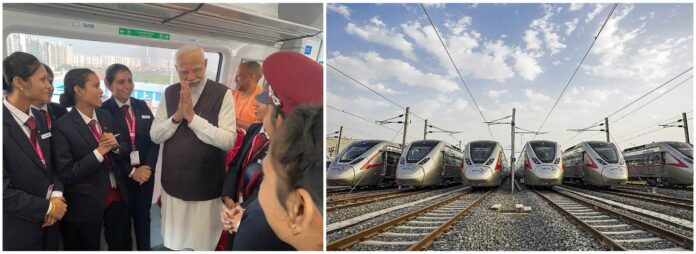In a historic moment for Indian transportation, Prime Minister Narendra Modi officially inaugurated India’s first semi-high-speed regional rail service. Just one day before its highly-anticipated launch, the rail service underwent a significant rebranding, transitioning from RapidX to the newly christened NaMo Bharat, a name that resonates with the essence of this pioneering project.
In a momentous stride towards the future of Indian railways, a significant development is on the horizon. The commencement of passenger operations on the 17-kilometer priority section of the Delhi-Ghaziabad-Meerut Regional Rapid Transit System (RRTS) Corridor is scheduled for Saturday. This historic event marks the introduction of the Regional Rapid Transit System (RRTS) in India, a groundbreaking initiative set to transform the way people commute and usher in a new era in Indian transportation.
Connecting Sahibabad and Duhai Depot Stations
The 17-kilometer priority section of the RRTS Corridor is set to connect the Sahibabad and Duhai Depot stations. This stretch represents the inaugural phase of a comprehensive project designed to provide efficient, high-speed, and eco-friendly transportation services, ultimately spanning the entire Delhi-Ghaziabad-Meerut corridor.
The RRTS: Redefining Indian Railways
The Regional Rapid Transit System (RRTS) is a revolutionary concept in Indian rail transportation. It is conceived to be an intercity rail network that will seamlessly connect India’s National Capital Region (NCR), offering a high-speed and efficient mode of travel. RRTS is engineered to alleviate traffic congestion, reduce travel time, and promote sustainable, eco-friendly commuting solutions.
Key Features of the RRTS
The Delhi-Ghaziabad-Meerut RRTS Corridor, with its high-speed trains, modern stations, and advanced technologies, aims to offer several noteworthy features:
-
Swift Connectivity: RRTS will dramatically reduce travel times, making daily commutes and intercity travel faster and more convenient for commuters.
-
Environmentally Conscious: The project places a strong emphasis on environmental sustainability, promoting cleaner, greener travel with reduced emissions.
-
Affordability: The RRTS is designed to be affordable, catering to a wide spectrum of commuters and ensuring accessibility for all.
-
Safety First: Stringent safety standards are at the core of RRTS, ensuring a secure and dependable mode of transportation.
-
Economic Prosperity: By connecting urban and economic hubs, the RRTS is expected to stimulate economic growth in the regions it serves.
A Leap into the Future
As India stands on the cusp of introducing RRTS in its transportation network, it marks a giant leap into the future. The Delhi-Ghaziabad-Meerut RRTS Corridor is just the beginning of what promises to be a transformative journey for the country’s railways, benefiting millions of commuters and fostering economic growth.
An Emblem of Progress
The inauguration of the 17-kilometer section of the Delhi-Ghaziabad-Meerut RRTS Corridor is not merely a rail service; it is a symbol of India’s unwavering commitment to modernization, innovation, and sustainable development. This project is poised to set the stage for a transportation revolution, one that redefines how India moves and connects within its growing cities.
As the first trains of the Delhi-Ghaziabad-Meerut RRTS Corridor roll out, they signify a brighter and more connected future for the nation, where speed, efficiency, and sustainability are at the forefront of Indian transportation.






















